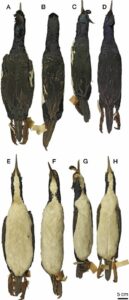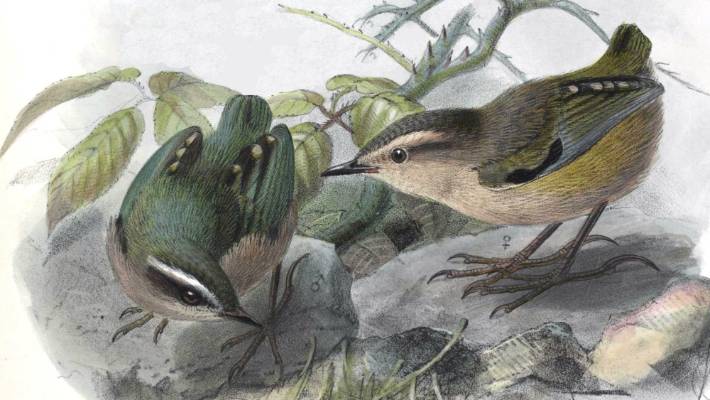I’m staring at an evolutionary tree of New Zealand wrens when ‘damn it Travers’ rings out. The infamous Victorian collector Henry Hamersley Travers had just struck again.
In front of me also are the delicate historical skins of some of these tiny wrens, frozen in time since the day they were collected. While some are still with us like the pīwauwau rock wren (Xenicus gilviventris), others are extinct like mātuhituhi bush wren (X. longipes) that was only driven to extinction by rats a mere ten years before I was born. More so than fossil bones, these precious skins are hauntingly beautiful in their detail. No need to infer what they looked like alive.
It’s skins like these, and other historical museum specimens, that offer scientists and conservationists a unique window into how our unique biodiversity was faring at the time of European arrival. Having survived the impacts of Polynesian colonisation, some by the skin of their beak, our biodiversity was about to face a new swathe of threats from further environmental modification, ruthless predators, and the museum trade.
Some important historical collectors in Aotearoa are household names like Sir Walter Buller, author of Buller’s Birds of New Zealand. I still remember the thrill of looking through a copy at Bruce Thomas’s (of Breaksea Island rat eradication fame) house down the road from my childhood home. Other collectors will be new to most people such as Andreas Reischek and Henry Hamersley Travers. While the museum trade no doubt contributed to the extinction of some species such as the huia (Heteralocha acutirostris) and Auckland Island merganser (Mergus australis), it’s fitting that historical specimens are now providing the vital who, where, what, wren – biological heritage if you will – that allows for evidence-based ecological restoration and species translocation.
In geology there’s a saying, “the past is the key to the present” and I would argue, also the future. In other words, when conserving species, ignore their past at your peril. But what if that history was wrong?
It all started with a rock wren
In the collections of the British Museum of Natural History lies a rock wren that caught the attention of New Zealand’s Department of Conservation (DOC). But not just any rock wren. The label attached to this old skin said “Rimutaka Ranges”, in the lower North Island. The little bird was collected before the 1930s, though the precise collection date and collector are unknown. This lack of historical information set the alarm bells ringing.
Either we had the first known historical record of rock wren from the North Island, allowing DOC to potentially translocate individuals from the South Island, or we had a rock wren from the South Island with a dodgy label. Another possibility was that this little bird wasn’t even a rock wren but an imposter, a morphologically similar bush wren masquerading as a rock wren. Preserved within this precious specimen are fragments of its genetic blueprint, breadcrumbs that sleuths can use to reconstruct an individuals’ true biological heritage.
What Alex found would illustrate that you can’t take metadata associated with historical museum specimens at face value. The good news was that this specimen was a rock wren. The bad news, it wasn’t from the Remutaka’s. Far from it. Rather it was collected from southern Fiordland. Sorry, no historical record of a North Island rock wren here folks.
Not only that, but skins from the infamous Henry Travers, including one sourced from “Nelson” in 1899, and three skins collected in 1897 from “Otago Province”, had dubious locality data. The rock wren specimens from Otago were collected in the northern South Island, while the Nelson skin was from southern Fiordland. Damn and blast. So was this an isolated incident?

Romanes eunt domus or Romani ite domum
What Alex and I had discovered was just the tip of the iceberg, the latest in a long line of historical offenses conducted by Travers and others.
Travers wasn’t just guilty of suspect labelling of rock wren, but many other birds too. Eight hoiho yellow-eyed penguins (Megadyptes antipodes) that were collected from Auckland and Campbell Islands in 1893 or 1894 by Travers were actually from the South Island of New Zealand. Likely, he never visited these far-flung islands at the time.
Scientists at Victoria University were conned by him as well. Using a rare specimen of the extinct Macquarie Island parakeet (Cyanoramphus erythrotis) from Canterbury Museum, they concluded this species was genetically identical to Reischek’s parakeet (C. hochstetteri) from the distant Antipodes Island. Turns out Travers never visited Macquarie Island but did visit Antipodes Island, and the scientists had sequenced a Reischek’s parakeet!
Travers, until recently, was also credited with the discovery of the now-extinct tutukiwi South Island snipe (Coenocorypha iredalei), which was described based on skins purchased by Travers himself. Turns out only seven of the 24 known specimens have correct locality data, and that Travers didn’t collect any of them.
It’s not just Travers who is guilty. Remember Sir Walter Buller? Turns out Buller was pretty dodgy as well (I highly recommend reading The Reluctant Conservationist). Ironic really that the kid who loved Buller’s Birds of New Zealand ended up catching him in the act. While sampling blue-eyed shags collected by Buller in Canterbury Museum I noticed some of these birds were not like the other. A shag collected from Stewart Island was actually from the Auckland Islands, 400 km to the south. Another specimen, from the Chatham Islands, was from the Auckland Islands – a whopping 1500 km to the southeast.
Lost in translation or deliberate falsification?
Were all these travesties a result of deliberate fraud or poor record-keeping? It’s very hard to prove fraud. Competitive behaviour would have been common between rival collectors like Travers and Buller…just think of the dinosaur bone wars between Cope and Marsh. Extinct species like the Macquarie Island parakeet would have been worth more than Reischek’s parakeet. Hoiho from far-flung locales are worth more than their mainland counterparts that can still be seen today a short drive from my house. Money, money, money, it’s a rich man’s world.
On the other hand, poor record keeping is a given. None of Buller’s specimens in Te Papa Tongarewa have locality details on the original labels, and those in the American Museum of Natural History have multiple labels with different information indicating numerous sales of the same bird by Buller. He knew how to distinguish blue-eyed shags at the time the skins in Canterbury Museum were collected, so why did Buller get their identifications so wrong? Ad hoc labelling, sometimes years after the fact, and hastily prepared sales lists from memory, combined with a failure to verify species identifications, certainly didn’t help things.
So, the next time you are in a museum basement trying to work out where our precious natural taonga were in the past and how that might inform conservation management, tread carefully, follow the breadcrumbs, and just remember these historical collectors are not the messiah, they’re just a bunch of very naughty boys.

